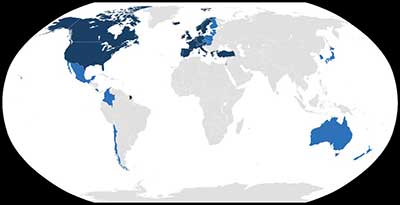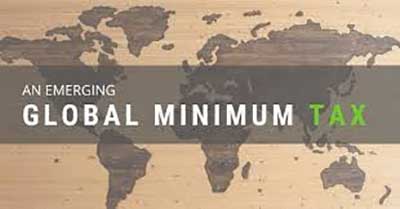Relevance: GS-3: Groupings & Agreements Involving India or Affecting India's Interests
Key phrases: Global Minimum Tax, OECD,
Why in News?
- The Organisation for Economic Co-operation and Development (OECD) on Monday published detailed rules to assist in the implementation of new international tax system, which will ensure multinational enterprises (MNEs) will be subject to a minimum 15 per cent tax rate from 2023.
What is Global Minimum Tax Rate?
- The global minimum corporate tax rate, abbreviated GMCT or GMCTR, is an agreement between national leaders which proposes to reduce tax competition between countries and the avoidance of corporate taxes by setting a world-wide minimum corporate tax rate.
- The global minimum tax attempts to limit tax competition by introducing a globally uniform floor, below which the effect of low tax rates or fiscal policy measures would be largely obviated.
- The OECD published detailed rules to assist in the implementation of a landmark reform to the international tax system, which will ensure Multinational Enterprises (MNEs) will be subject to a minimum 15% tax rate from 2023.
- The Pillar Two model rules provide governments a precise template for taking forward the two-pillar solution to address the tax challenges arising from digitalisation and globalisation of the economy agreed in October 2021 by 137 countries and jurisdictions under the OECD/G20 Inclusive Framework on BEPS.
- The rules define the scope and set out the mechanism for the so-called Global Anti-Base Erosion (GloBE) rules under Pillar Two, which will introduce a global minimum corporate tax rate set at 15%. The minimum tax will apply to MNEs with revenue above EUR 750 million and is estimated to generate around USD 150 billion in additional global tax revenues annually.
Why a Global Minimum Tax Rate?
- With budgets strained after the COVID-19 crisis, many governments want more than ever to discourage multinationals from shifting profits - and tax revenues - to low-tax countries regardless of where their sales are made.
- Increasingly, income from intangible sources such as drug patents, software and royalties on intellectual property has migrated to these jurisdictions, allowing companies to avoid paying higher taxes in their traditional home countries.
- The global minimum tax rate and other provisions aim to put an end to decades of tax competition between governments to attract foreign investment.
- GMCTR will end a decades-long race to the bottom in which countries have competed to attract corporate giants with ultra-low tax rates and exemptions. And it will bring uniformity in corporate taxation worldwide.
What is Pillar 1 and 2 of New Global Tax Regime?
- 136 member countries of the Organization of Economic Co-operation and Development (OECD) have agreed to shape up generally accepted international tax rules and principles of global tax arena by a historic drastic global tax reform of the century.
- It has two Pillars 1 and 2
- Pillar 1 deals with fairness in the sharing of revenues between and among countries owing to the rapidly increasing digitalization of the world’s businesses where territorial borders, brick-and-mortar presence, on which the current global tax rules are based, are becoming inapplicable.
- Pillar 2 deals with eradication of tax havens and the “race to the bottom” practice of tax cuts/lowered tax rates and offering attractive incentives in attracting businesses and investments, resulting in revenue imbalances and significant losses to governments. To accomplish this, a 15% global minimum corporate tax (effective tax rate) has been agreed upon.
- Both Pillar 1 and 2 will bring major changes to international tax rules and the New Regime is likely to be put in place by 2023

Organisation for Economic Co-operation and Development
- The Organisation for Economic Co-operation and Development (OECD) is an intergovernmental economic organisation with 38 member countries founded in 1961 to stimulate economic progress and world trade.
- It is a forum of countries describing themselves as committed to democracy and the market economy, providing a platform to compare policy experiences, seek answers to common problems, identify good practices and coordinate domestic and international policies of its members.
- Generally, OECD members are high-income economies with a very high Human Development Index (HDI) and are regarded as developed countries.
- As of 2017, the OECD member countries collectively comprised 62.2 % of global nominal GDP and 42.8 % of global GDP at purchasing power parity.

What the global minimum tax deal means for India?
- The global floor rate of 15% should help in creating a level playing field and boost the chances of foreign direct investment coming into India.
- India may have to withdraw digital services tax or the equalisation levy and give a commitment not to introduce such measures in the future if the global minimum tax deal comes through.
- However, under the new deal, the equalization levy imposed by the government would not hold once the global minimum tax becomes operational. India has around INR 4,000 crore as revenue from equalisation levy.The removal of equalisation levy is expected to cost India in terms of revenue.
- Due to India’s tax rates too, it will be in an advantageous position because Indian tax rates have come at a position where India can afford to give concessions to big companies and yet not fall down at the international tax rates.
Source: The Hindu BL
Mains Question:
Q. What is Global Minimum Tax Rate? What will be the economic impact of Global Minimum Tax Rate on India? Illustrate.









